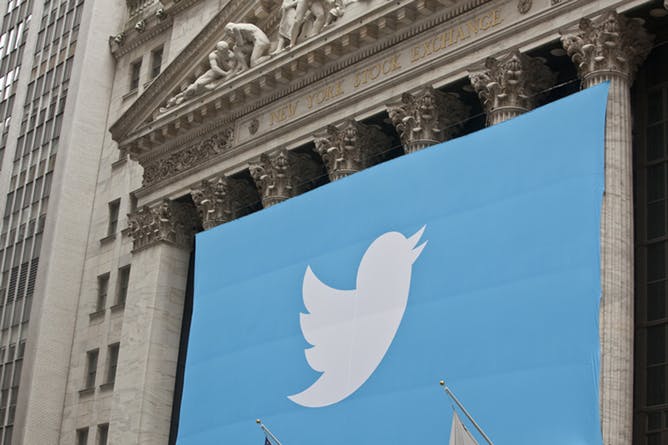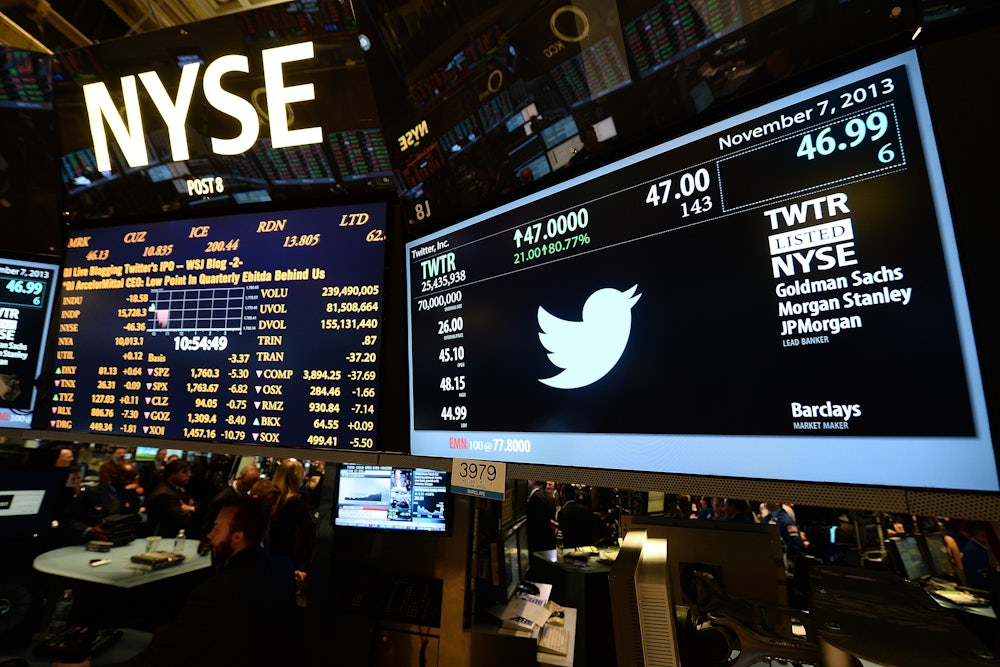Every day, hundreds of millions of messages are posted on Twitter. Researchers often see this avalanche of data as a gold mine, allowing them to measure in real time the attention, views and feelings of a huge sample of the population.
A number of recent studies have demonstrated how Twitter can be used to anticipate presidential elections, flu outbreaks or box-office results.
So could an analysis of Twitter data also help us predict changes in stock prices?
Two theories
There are two business theories that indicate Twitter could be useful in forecasting stock markets:
- An “informational” theory: Information published on Twitter is new, in the sense that it has not yet been incorporated into stock prices. That information can thus be expected to influence the value one could rationally expect for the future cash flows of an asset.
- A “sentimental” theory: The price of an asset deviates from its fundamental value depending on waves of optimism or pessimism, and Twitter enables the measurement of investor sentiment.
Anecdotally, it is possible to identify some situations where messages posted on Twitter have in fact “moved markets.” For example, on March 30 2015, a tweet from Elon Musk resulted in an increase of Tesla’s capitalization by approximately US$1 billion in just a few minutes.
Major new Tesla product line -- not a car -- will be unveiled at our Hawthorne Design Studio on Thurs 8pm, April 30
— Elon Musk (@elonmusk) March 30, 2015A somewhat similar story happened after a 2013 tweet from Carl Icahn led to increased capitalization of Apple of more than $10 billion.
We currently have a large position in APPLE. We believe the company to be extremely undervalued. Spoke to Tim Cook today. More to come.
— Carl Icahn (@Carl_C_Icahn) August 13, 2013But there is a profound difference between after-the-fact analysis of a few anecdotal events and the creation of a real-time, profit-generating trading strategy based on Twitter.
Depending primarily on the number of false alarms generated by a “Twitter strategy” and the speed with which prices are adjusted to reflect new information, the correlation between Twitter and the financial markets can quickly become unusable.
A matter of ‘feeling’
Academic research is currently focused on the second line of research, using Twitter as a proxy for investor sentiment. The standard methodology is to extract all tweets containing the name or ticker symbol of a listed company, then algorithmically assign to each message a “feeling” – positive, neutral or negative.
An aggregate rating is then created using the average of the values assigned to the tweets. The next step is to search for any causal link between the “social feeling” and the evolution of an asset’s prices, correcting for the level of risk.

Mixed results
For now, as for all research on predicting changes in the price of financial assets by using data from the internet and social networks, the results are rather mixed (here is a comprehensive review of the literature).
Two recent papers, Tweets and Trades: The Information Content of Stock Microblogs and The Effects of Twitter Sentiment on Stock Price Returns, arrive at essentially the same conclusion: there is a correlation between the “social feeling” for a particular stock and the evolution of financial markets, but not causality. In other words, Twitter is not a crystal ball that can predict markets, but rather a mirror reflecting the current situation.
Research on this subject is still in its infancy, however, partly because of the lack of free historical data and the technical skills required to extract and analyze this kind of unstructured data.
Many methodological and theoretical questions remain unanswered, such as: how can we improve the accuracy of the analysis of the “feeling” of tweets? Is it better to adjust the value assigned to a tweet based on who the sender is? How can we test the “informational” theory using high-frequency data? To decrease the number of “false alarms,” should Twitter signals be combined with other sources of data, such as traditional media or search volumes on Google?
For the moment, however, as the Tweets and Trades study indicates, “picking the right tweets remains just as difficult as making the right trades.”
![]()
This article was originally published on The Conversation. Read the original article.
